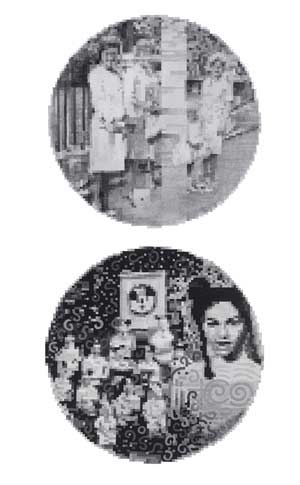

Myths of my Ancestors
All art is only half real. It inhabits that space between the world we live in, the world we dream of, the world of our memories, and the world of the work of art.
Deborah Adams Doering's work is an exploration of the relationship between art and life. It mixes abstracted images, thoughts voiced in words, and objects, to create a kind of voyage, not with a particular destination, but a voyage of observation, a voyage of distance measured in knowing.
In Myths of My Ancestors, an installation series, Doering observes certain aspects of her early life. She exhibits a childhood where there were few male anchors. Her great-grandfather, a man who achieved fame as a marathon runner, died at a young age of a freak accident; jumping over a gate, his wedding ring caught on a laundry hook and his finger was ripped from his hand. Death from lockjaw ensued. This was one of several events that led to a dearth of male figures in her family, events that Doering outlines in her narrative artist statement. Grandfathers and fathers, uncles and brothers, these persons usually form a kind of secure groundwork for any family, and the lack of close male relatives while growing up gave the artist a feeling of drifting, of an unanchored virtual reality.
Doering's art is in some ways an extension of this "seeking an anchor" in a world which appeared a foreign and curious place to her during her Midwestern American childhood. Her search motivates her particular sensitivity to environments, and the changes of and in environments.
Changes, transformations, the meaning of moving from one state of being to another, run through her art. Her earlier work, large brightly colored paintings based on electronic imagery, reflect a sense of place; gardens, interiors of churches, train stations, and other "human places" like weddings, dances, people in galleries. These art works are, as it were, placed at a distance, by the use of techniques of digitization (using geometric shapes like bricks of structure to make an image) thus reducing the detail of places and people to semi-abstract constructions. As a result, the viewer must assemble the figurative image in their minds' eye, adding that last element of reality out of their own memories.
Doering's earlier work thus challenges the viewer to supply information that completes the image, an activity that assumes a major role in Myths of My Ancestors. Black and white circular watercolor paintings (again using the technique of digitization) give an air of vagueness, echoing the way we often remember things from our early life. We in the present must "connect the dots" as it were, to allow them to coordinate with our current life situation.
In her Anon Text Messages (each is a large, flat, scroll-like work on paper, painted with very fluid black acrylic paint), Doering creates a visual language akin to text. These hand-calligraphed codes may be seen as characters suggesting an object or event in an individual's life; for example, one might imagine a wedding ring, a hook, and a dismembered finger, floating horizontally and vertically in the "text."
But the text-patterns go beyond the personal; these graphic symbols, sometimes vaguely sexual, suggest life's processes relating to growth or stasis. They are the bits and pieces of life as we find it, objects and processes that create, almost literally, a kind of grid of thoughts, which, if properly interpreted, hint at how we are positioned in life, where we find ourselves. These works bear strong resemblance to architectural floor plans for buildings, or designs for the laying out of gardens, suggesting the groundwork for environments.
Doering's interest in orienting oneself in an environment translates readily to creating a "text message" on the ground in a vast area of fallow farmland. Her codes are mowed in a 12-acre field, revealing the soil which creates an "ink" that paints an image on the ground. In her gallery installations, text-code is counter-pointed with digitized images, but in her text on the land, the counterpoint is with the natural environment; sun, wind, and plant life. This work provides a more open-ended dialogue, where nature's moods become part of the equation, extending the range of her metaphors from the private world of families and interior spaces to the laws of nature and the way they structure a sense of place.
In all it's manifestations, Doering's work asks the questions, "What is this place, how do we relate to it, what are the codes that we measure it by, and how do we fit into or do not fit into a place?" Her ongoing work may well engage the poetry of T.S. Eliot in "Little Gidding" from his "Four Quartets,"
"We shall not cease from exploration,
And the end of all our exploring
Will be to arrive where we started
And know the place for the first time."
Robert Kameczura
Art Critic, Big Shoulders Magazine